Cite this document
(“Strengths and Weaknesses of Zartmans concept of Ripeness Book Report/Review”, n.d.)
Retrieved de https://studentshare.org/people/1505402-strengths-and-weaknesses-of-zartmans-concept-of-ripeness
Retrieved de https://studentshare.org/people/1505402-strengths-and-weaknesses-of-zartmans-concept-of-ripeness
(Strengths and Weaknesses of Zartmans Concept of Ripeness Book Report/Review)
https://studentshare.org/people/1505402-strengths-and-weaknesses-of-zartmans-concept-of-ripeness.
https://studentshare.org/people/1505402-strengths-and-weaknesses-of-zartmans-concept-of-ripeness.
“Strengths and Weaknesses of Zartmans Concept of Ripeness Book Report/Review”, n.d. https://studentshare.org/people/1505402-strengths-and-weaknesses-of-zartmans-concept-of-ripeness.


